NBA Fantasy Trends: Stats: A View to Thrill
It happens all too often when a player kind of seems like he’s not the centerpiece in a trade, but a breakout totally changes the perception. Tobias Harris wasn’t getting playing time with the Bucks and was not the focal point of a deal that sent sharp-shooting, highly-coveted J.J. Redick from Orlando to Milwaukee in 2013 — Redick bolted for the Clippers after 1.5 months — and Jae Crowder was an afterthought in the Rajon Rondo deal last season.
Will Barton was essentially just a piece to make the money work for the Nuggets when they got a 2016 first-round pick from the Blazers in the Arron Afflalo deal at the deadline last year. Now, Barton is dominating as a Most Improved Player candidate.
Follow me on Twitter @MikeSGallagher for stats, analysis, Vines and more.
On the season, Will the Thrill has averages of 14.7 points, 5.8 boards, 2.0 assists, 0.5 blocks, 1.3 steals, 1.5 treys and 1.4 turnovers on 45.8 percent from the field and 86.3 percent from the line. That’s good for a 56.9 true shooting percentage (TS%) with his 22.3 usage rate. Pretty solid.
Last season, Barton only had a 20.2 usage rate and a 50.3 TS%, so a six percent bump is pretty nice. Like most scoring guards, the improvement comes from outside of the paint. Here’s a look at Barton’s shot chart from this year (top) and last year (bottom):
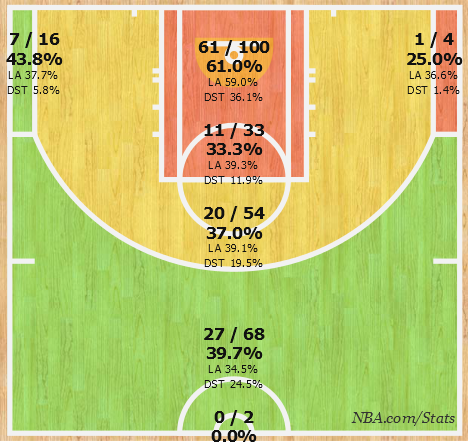

His distribution on mid-range shots is identical, but he’s up 6.6 percent this year. Plus, the 3-point shooting is obviously the big difference and that really explains the increase in efficiency by itself. He’s taken 31.7 percent of his shots from deep, which jumps up from 23.5 percent, and he increased his total 3-point shooting from 27.1 to 38.9.
The biggest difference for Barton is how much he’s scoring on catch-and-shoot shots. Last year, only 31.4 percent of his shots were without a dribble, but that’s up to 42.8 percent this year. Typically, that’s a really good sign and Barton also increased his effective field goal percentage (eFG%) on those shots 9.8 percent, too. When he’s scoring off the dribble, his effectiveness is really similar, so that’s another good sign of this increased output being sustainable.
When Mudiay is off the court, Barton has a 23.5 usage rate. When he’s on the court, Barton has a 20.8 usage rate, so it’s not a surprise to see Barton getting more shots in that time. In other words, we’ll probably see Thrill live up to his name even more while Mudiay recovers from his bum ankle.
On the reality side of things, he’s an absolute steal for the Nuggets at $3.5 million per year for two more seasons before he’s an unrestricted free agent, so the Nuggets won’t be dealing him. If you own him, you are going to have a fun ride. He probably won’t be a third-round guy like he is now, but top 60 sees totally doable for standard leagues.
In his last eight games played, here’s his shot chart:

That’s a pretty shot chart right there. He’s getting 46 percent of his shots at the rim and he’s converting above league average at his 63.2 percent. Of course, you have to love the low mid-range shots and the high volume efficiency on those treys.
Why? It’s all about touch time. In that eight-game run, Harris has a touch time of less than two seconds 68.7 percent of the time. Plus, he’s been open a lot too. On his 41 shots from beyond 10 feet in his last eight, he’s only had a defender within four feet of him just seven times.
Harris won’t be playing 42 minutes per game, but we can probably expect him to be in the mid 30s. If he is going to take treys, get to the rim, make free throws at his current 81.8 percent clip, and keep his steal rate similar, he should have value in standard leagues. I’d pick him up almost everywhere to see what happens.
However, PG’s not just missing shots. He is making it a lot harder on himself. Here’s a look at his shot chart in his last four (top) and his first 19 games (bottom) of the season:

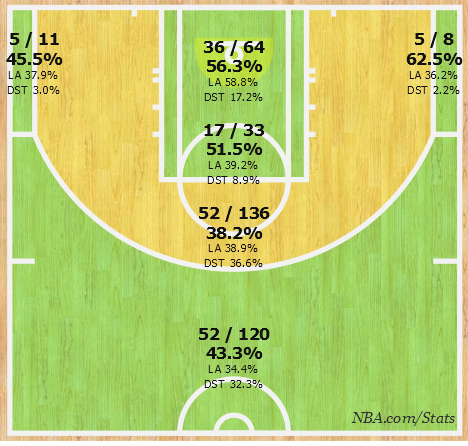
The obvious difference is that he’s been awful on mid-range shots and he’s not automatic on treys. The good news is that he’s getting to the rim more, which makes sense because teams are guarding him a little tighter now.
Speaking of which, he’s really seen an increase in tight defense. Here’s a look at his off-dribble and closest-defender numbers from his cold four-game stretch (top) and previous 19 games:
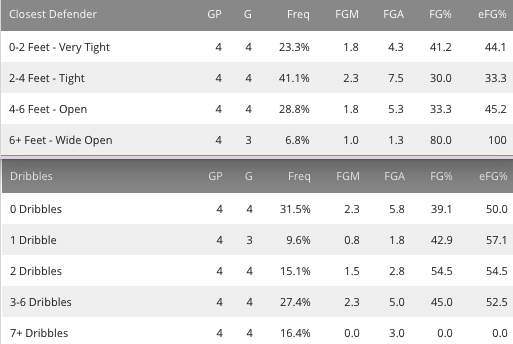
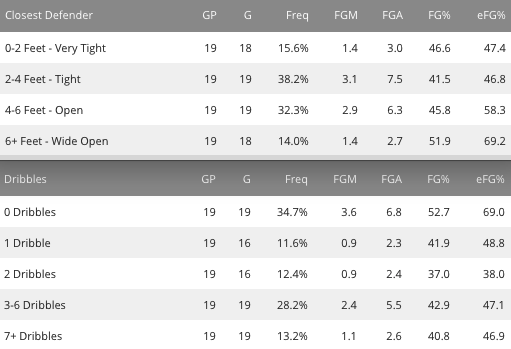
That’s a pretty big difference, huh? In his last four, he’s faced tight defense a whopping 10.6 percent more. He’s also missed all 12 shots with seven-plus dribbles in his last four and he’s doing more two-plus dribbling recently, too.
Everyone knew PG wasn’t going to be as great as he was in November, but this recent cold spell is really a perfect way to illustrate how perimeter scorers can struggle. If you own him in fantasy, your sell-high window is probably closed and it doesn’t help he didn’t put up top-35 value in January-April in his breakout year back in 2013-14. I’d peg him as a top 10-15 guy going forward and not the No. 8 guy he is right now.
One other interesting thing was how much PG mania was taking over in late November. I took a Twitter poll asking people if they prefer KD or PG for nine-cat leagues, here were the results.

Crazy. KD would easily be No. 2 pick in my eyes. KD is putting up the quietest high-volume 50/40/90 of all time on the season. Let’s end the column on KD’s shot chart for the season:
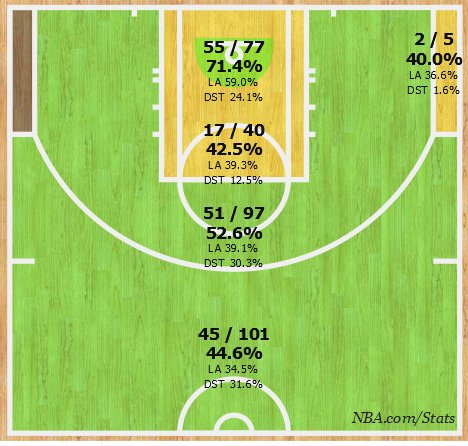
This entry passed through the Full-Text RSS service – if this is your content and you’re reading it on someone else’s site, please read the FAQ at fivefilters.org/content-only/faq.php#publishers.